英汉翻译教程1
- 格式:ppt
- 大小:3.19 MB
- 文档页数:41
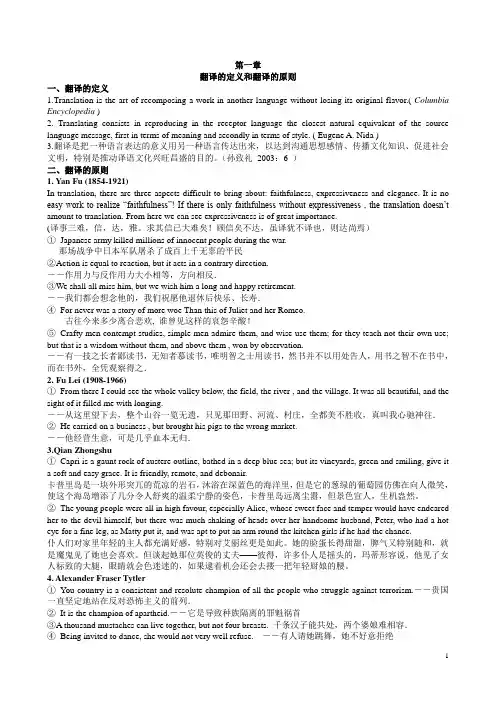
第一章翻译的定义和翻译的原则一、翻译的定义1.Translation is the art of recomposing a work in another language without losing its original flavor.( Columbia Encyclopedia )2. Translating consists in reproducing in the receptor language the closest natural equivalent of the source language message, first in terms of meaning and secondly in terms of style. ( Eugene A. Nida )3.翻译是把一种语言表达的意义用另一种语言传达出来,以达到沟通思想感情、传播文化知识、促进社会文明,特别是推动译语文化兴旺昌盛的目的。
(孙致礼2003:6 )二、翻译的原则1. Yan Fu (1854-1921)In translation, there are three aspects difficult to bring about: faithfulness, expressiveness and elegance. It is no easy work to realize ―faithfulness‖! If there is only faithfulness without expressiveness , the translation doesn’t amount to translation. From here we can see expressiveness is of great importance.(译事三难,信,达,雅。
求其信已大难矣!顾信矣不达,虽译犹不译也,则达尚焉)①Japanese army killed millions of innocent people during the war.----那场战争中日本军队屠杀了成百上千无辜的平民②Action is equal to reaction, but it acts in a contrary direction.――作用力与反作用力大小相等,方向相反.③We shall all miss him, but we wish him a long and happy retirement.――我们都会想念他的,我们祝愿他退休后快乐、长寿.④For never was a story of more woe Than this of Juliet and her Romeo.古往今来多少离合悲欢, 谁曾见这样的哀怨辛酸!⑤Crafty men contempt studies, simple men admire them, and wise use them; for they teach not their own use; but that is a wisdom without them, and above them , won by observation.――有一技之长者鄙读书,无知者慕读书,唯明智之士用读书,然书并不以用处告人,用书之智不在书中,而在书外,全凭观察得之.2. Fu Lei (1908-1966)①From there I could see the whole valley below, the field, the river , and the village. It was all beautiful, and the sight of it filled me with longing.――从这里望下去,整个山谷一览无遗,只见那田野、河流、村庄,全都美不胜收,真叫我心驰神往.②He carried on a business , but brought his pigs to the wrong market.――他经营生意,可是几乎血本无归.3.Qian Zhongshu①Capri is a gaunt rock of austere outline, bathed in a deep blue sea; but its vineyards, green and smiling, give ita soft and easy grace. It is friendly, remote, and debonair.卡普里岛是一块外形突兀的荒凉的岩石,沐浴在深蓝色的海洋里,但是它的葱绿的葡萄园仿佛在向人微笑,使这个海岛增添了几分令人舒爽的温柔宁静的姿色,卡普里岛远离尘嚣,但景色宣人,生机盎然。

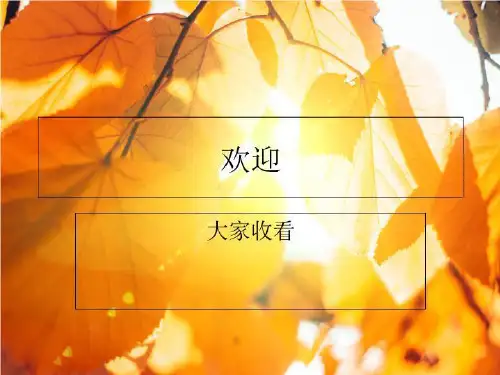
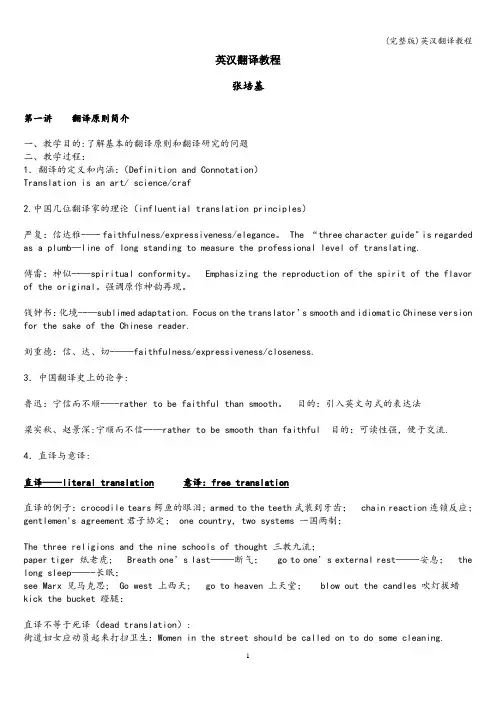
英汉翻译教程张培基第一讲翻译原则简介一、教学目的:了解基本的翻译原则和翻译研究的问题二、教学过程:1.翻译的定义和内涵:(Definition and Connotation)Translation is an art/ science/craf2.中国几位翻译家的理论(influential translation principles)严复:信达雅-—- faithfulness/expressiveness/elegance。
The “three character guide" is regarded as a plumb—line of long standing to measure the professional level of translating.傅雷:神似--—spiritual conformity。
Emphasizing the reproduction of the spirit of the flavor of the original。
强调原作神韵再现。
钱钟书:化境--—sublimed adaptation. Focus on the translator’s smooth and idiomatic Chinese version for the sake of the Chinese reader.刘重德:信、达、切-——faithfulness/expressiveness/closeness.3.中国翻译史上的论争:鲁迅:宁信而不顺-—-rather to be faithful than smooth。
目的:引入英文句式的表达法梁实秋、赵景深:宁顺而不信--—rather to be smooth than faithful 目的:可读性强,便于交流.4.直译与意译:直译—--literal translation意译:free translation直译的例子:crocodile tears鳄鱼的眼泪; armed to the teeth武装到牙齿; chain reaction连锁反应;gentlemen's agreement君子协定; one country, two systems 一国两制;The three religions and the nine schools of thought 三教九流;paper tiger 纸老虎; Breath one’s last——-断气; go to one’s external rest——-安息; the long sleep——-长眠;see Marx 见马克思; Go west 上西天; go to heaven 上天堂; blow out the candles 吹灯拔蜡kick the bucket 蹬腿:直译不等于死译(dead translation):街道妇女应动员起来打扫卫生:Women in the street should be called on to do some cleaning.“In the street" should be replaced by “in the community”.她一大早起床,进城,见到了她的公爹:She got up early, went to the town and saw her public father。
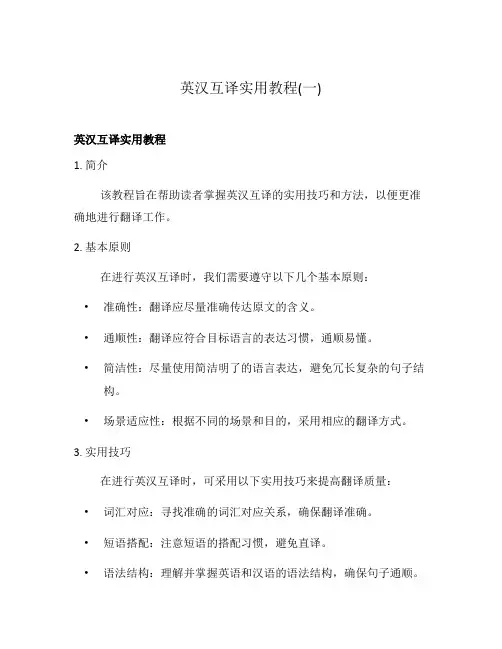
英汉互译实用教程(一)英汉互译实用教程1. 简介该教程旨在帮助读者掌握英汉互译的实用技巧和方法,以便更准确地进行翻译工作。
2. 基本原则在进行英汉互译时,我们需要遵守以下几个基本原则:•准确性:翻译应尽量准确传达原文的含义。
•通顺性:翻译应符合目标语言的表达习惯,通顺易懂。
•简洁性:尽量使用简洁明了的语言表达,避免冗长复杂的句子结构。
•场景适应性:根据不同的场景和目的,采用相应的翻译方式。
3. 实用技巧在进行英汉互译时,可采用以下实用技巧来提高翻译质量:•词汇对应:寻找准确的词汇对应关系,确保翻译准确。
•短语搭配:注意短语的搭配习惯,避免直译。
•语法结构:理解并掌握英语和汉语的语法结构,确保句子通顺。
•上下文理解:通过上下文理解原文的意思,以便更好地进行翻译。
•文化差异:考虑文化差异对翻译的影响,尽量做到意译。
4. 实例演练下面是一些实例演练,旨在帮助读者更好地理解和掌握英汉互译的实用技巧:1.英文句子:“The cat is on the table.” - 翻译成中文:“猫在桌子上。
”2.中文句子:“这是我的手机。
” - 翻译成英文:“This is my cell phone.”3.英文短语:“It’s raining cats and dogs.” -翻译成中文:“下大雨了。
”4.中文短语:“明天见。
” - 翻译成英文:“See youtomorrow.”5. 注意事项在进行英汉互译时,需注意以下几个事项:•专有名词:对于专有名词,应保持与原文一致。
•文化差异:根据不同的文化背景,适当进行意译,以便更好地传达信息。
•翻译细节:注意细节的处理,如时态、人称、单复数等。
6. 总结通过本教程的学习,读者可以掌握英汉互译的实用技巧和方法,提高翻译准确性和表达流畅度。
在实践中不断积累经验,不断提升翻译能力,才能成为一名出色的创作者。
希望本教程能帮助到您,在英汉互译的道路上取得更好的成绩!7. 深度学习在提高英汉互译能力的过程中,深度学习是一个重要的方向。
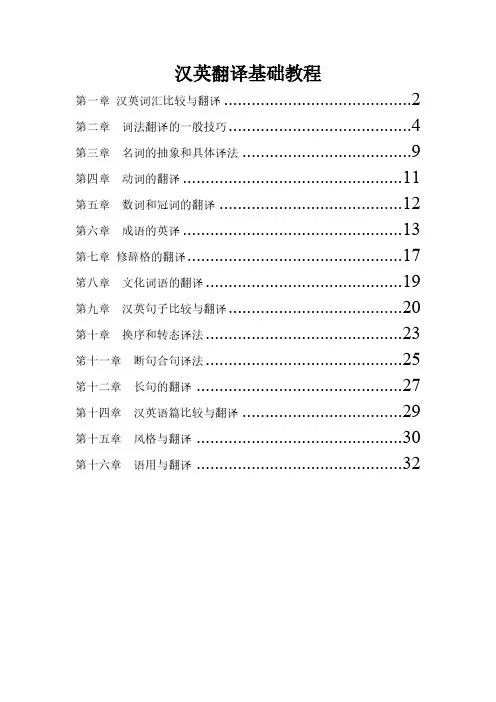
汉英翻译基础教程第一章汉英词汇比较与翻译 (2)第二章词法翻译的一般技巧 (4)第三章名词的抽象和具体译法 (9)第四章动词的翻译 (11)第五章数词和冠词的翻译 (12)第六章成语的英译 (13)第七章修辞格的翻译 (17)笫八章文化词语的翻译 (19)第九章汉英句子比较与翻译 (20)第十章换序和转态译法 (23)笫十一章断句合句译法 (25)笫十二章长句的翻译 (27)第十四章汉英语篇比较与翻译 (29)第十五章风格与翻译 (30)第十六章语用与翻译 (32)第一章汉英词汇比较与翻译第一节翻译中的选义一、结合语境选择较贴切的译文1. b2. a3. b4. a二、译出下列词语,注意词语的不同搭配1. a swarm of beesa brood of chickensa litter of pups2. a bevy of beautiful ladiesa pack of houndsa team of ducksa herd of antelopes3. unfailing supportproactive fiscal policymake effective use of overseas resources4. make a phone calltake a taxiknit a woolen sweaterfetch waterplay basketballspray insecticide5. basic wagecapital constructionessential commodityprimary industryfundamental interest三、翻译下列句子,注意画线词语的理解1. The two leaders exchanged views on bilateral relations and issues of common concern2. Party members should listen carefully to the opinions of the general public.3. They offered some suggestions for the revision of the plan.4. Everyone complained against such a practice.5. They had a dispute at the meeting.6. You should follow the doctor's advice.7. They reached a consensus on this issue.8. There is still some unfinished business to settle.9. We have consulted him about the matter.10. Please go back. There is nothing of your concern now第二节翻译中的选词一、翻译下列各句,注意词的选择和搭配。
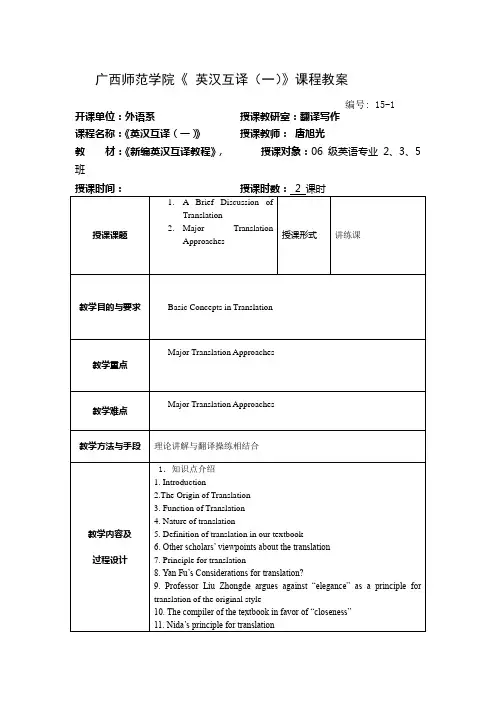
广西师范学院《英汉互译(一)》课程教案编号: 15-1 开课单位:外语系授课教研室:翻译写作课程名称:《英汉互译(一)》授课教师:唐旭光教材:《新编英汉互译教程》,授课对象:06级英语专业2、3、5班《英汉互译(一)》第一讲翻译简论与主要翻译方法(A Brief Discussion of Translation and Major Translation Approaches)1. IntroductionTranslation studies started along with translation practice. Translation theories developed flourishingly in the 20th century, especially in the second half of the last century.In fact, translation, which is a very complex phenomenon, is related to different disciplines, such as linguistics, psychology, sociology, cultural anthropology, communication theory, literary criticism, aesthetics, and semiotics. As translation study is a cross-discipline and cross-culture subject involving many aspects of human knowledge, the lack of a fully acceptable theory of translation should not come as a surprise. Meanwhile, quite a number of translation approaches and strategies have become universally acceptable and widely applicable. They are, of course, the fruits of many translation theorists and translation practitioners at home and abroad.2.The Origin of TranslationLanguage makes it possible for people to communicate with one another freely so as to complete important tasks in human life. Translation makes it possible for people from different languages to communicate with one another so as to complete important tasks in their life.Theodore Savory points out, “Translation is almost as old as original authorship and has a history as honorable and as complex as that of any other branch of literature”(申雨平, 2002:4).In Zhou Dynasty there were different forms of address for translators in different places. “Translators are called Ji in the east, Xiang in the south, Didi in the west, andYi in the north(东方曰寄,南方曰象,西方曰狄鞮,北方曰译)”(陈福康, 2000:3).3. Function of TranslationIt has helped people to better communicate with one another, and in the mean time it has facilitated the development of culture and civilization of all nations, such as the Sutra translation (佛经翻译)in China and the Bible translation in Western countries.Actually, translation, as a means to bridge different cultures, has been playing a very important role in promoting global economic and cultural development, and China in particular benefits a great deal from translation, which is obvious to all.4. Nature of translationOne school of theorists maintain that any interpretation is translation. Translation thus defined includes intra-lingual rewording(语言内的重新措辞), inter-lingual (语言之间的翻译或语际翻译)translation and inter-semiotic transmutation(符号转换).But most scholars who are interested in translation maintain that translation is a communicative activity which entails a most adequate or identical reproduction in a target language of a written message or text in a source language.5. Definition of translation in our textbook as follows: Translation or translating is a communicative activity or dynamic process in which the translator makes great effort to thoroughly comprehend a written message or text in the source language and works very hard to achieve an adequate or an almost identical reproduction in the target language version of the written source language message or text. In terms of its nature or character, translation is both an art and a science as well, since it calls for a good command of at least two languages, a flexible application of their rules, and some knowledge of at least two cultures, as well as a good grasp of the necessary translation theories.6. Other scholars’ viewpoints about the translation1). The traditional viewpoint about the nature of translation is that translation is an art only. This viewpoint is still maintained by Xu Yuanchong(许渊冲), a well-known professor at Beijing University, and a few other scholars.2). Professor Liu Zhongde vigorously advocates that translation is a science as well as an art mainly because of the following reasons:Firstly, like any other art and science, translation requires a good grasp and a flexible use of the necessary specialized knowledge and skills.Secondly, like any other art and science, translation calls for independent, honest and creative effort.Thirdly, just like any other art and science, translation demands that the translator be very careful about and highly responsible for his or her work.7. Principle for translationThe 13 statements on page 81). A translation must reproduce the words of the SLT(Source Language Text).2). A translation must reproduce the ideas (meaning) of the SLT.3). A translation should read like an original work.4). A translation should read like a translation.5). A translation should reflect the style of the original.6). A translation should possess the style of the translator.7). A translation should retain the historical stylistic dimension of the SLT.8). A translation should read as a contemporary piece of literature.9). A translation may add to or omit from the original.10). A translation may never add to or omit from the original.11). A translation should let the readers of the SLT and the target language text (TLT) have essentially the same response.12). A translation should convey what the SLT author intends to convey.13). A translation should satisfy the need of the client.Evidently, though each of the above statements is right in a certain sense, yet it is not adequate or comprehensive enough to serve as a translation principle. Some of the principles proposed by various translation theorists can find their expression in the statements given above. Interlinear translation is an illustration of the first statement. Yan Fu’s three-character principle can be a combination of statements 2, 3 and 6. Nida’s functional equivalence is best express ed in statement 11.8. Yan Fu’s Considerations for translation?Strictly speaking, a translation theory in its true sense in China originated from Yan Fu(严复). He proposed the famous triple principle for translation, namely, faithfulness(信), expressiveness(达) and elegance(雅).1). His faithfulness means that the translated text should be faithful to the original text, ie, the version should keep the content or ideas of the original.2). His expressiveness means that the translated text should be expressive and coherent without anything awkward. In other words, his expressiveness requires that the version should be fluid, smooth, and easy to read and understand.3). His elegance demands that the translated text should be exquisite and that its style ought to be very graceful.9. Professor Liu Zhongde argues against “elegance” as a principle for translation of the original styleHe argued eloquently against “elegance” as a principle for translation of the original style. We all know that not all works are characterized by the elegant style. Different writers display different styles. For instance, Lenin wrote in a bold style, and Hemingway wrote in a simple, symbolic style. Even the same writer shows different styles on different occasions for different purposes. Naturally, different works demonstrate different styles. Thus, it is impossible & absolutely wrong to achieve the effect of elegance in the translated text if the style of the original is not elegant.10. The compiler of the textbook in favor of “closeness”1). We are in favor of Professor Liu’s triple translation principle. He changed Yan Fu’s “elegance” into “closeness”, which represents his contribution to the translation theory. His “closeness” is central in meaning. It is suitable for translation of all types of texts with different styles.2). If the original text is characterized by the elegant style, the translator should do his utmost to render it into a graceful text in the target language whose style is close to the original elegant style.If the original style is highly technical with a wealth of technical terms, thetranslator ought to employ plenty of corresponding technical terms in the target language and make the translated style as close to the original technical style as possible.3). If the original style is colloquial with a lot of informal words and colloquial sentences, the translator should translate it into a text with an informal style as close as possible to the original one by using many colloquial words and informal sentences.If the original style is ornate, the translator should follow suit and make effort to render the translated style as close to the original as possible.If the original text contains some vulgar words and sentences, the translator is not entitled to replace them with elegant words or sentences, and he should reproduce the original by using some corresponding vulgar words and sentences in the receptor language. Translators are duty-bound to do so, for the simple reason that they are translators.4). As we know, Yan Fu’s triple translation principle is highly concise and well rhymed and quite easy to learn by heart, which is one of the reasons why it is still very popular in China today.Professor Liu’s triple principle is similar to Yan Fu’s in that it is equally concise and easy to remember.Though Professor Liu’s triple principle is n ot rhymed, yet it is very forceful and impressive, for the Chinese character “切” is uttered in the falling tone, carrying the implication that faithfully conveying the original style or rendering the translated style as close to the original as possible is absolutely necessary and worth the translator’s great effort.11. Nida’s principle for translationEugene A. Nida and Taber stated emphatically (1969:12): “Translation consists in reproducing in the receptor language the closest natural equivalence of the source language message, first in terms of meaning and secondly in terms of style”.His dynamic equivalence is defined as a translation principle, according to which the translator seeks to translate the meaning of the original in such a way that the target language text wording will produce the same impact on the target text audience as the original wording does upon the source text audience. Later on, Nida changed “dynamic equivalence” into “functional equivalence”, because it seemed much more satisfactory to use the expression “functional equivalence” in describing the degree of adequacy of a translation.12. The literal translation approachProfessor Liu Zhongde (1994: 172) defines literal translation as follows: “In the process of translation, literal translation treats sentences as basic units and at the same time takes the whole passage into consideration; a translator who attaches great importance to literal translation does his or her best to reproduce the ideas and writing style of the original work, retaining in the version as many rhetorical devices and sentence structures of the original as possible.”ExamplesHe is said to be a rough diamond.人们说他是一块浑金璞玉。
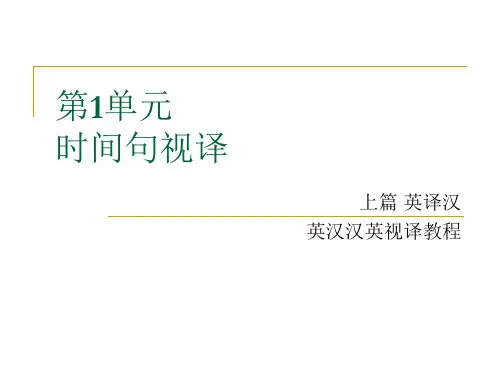
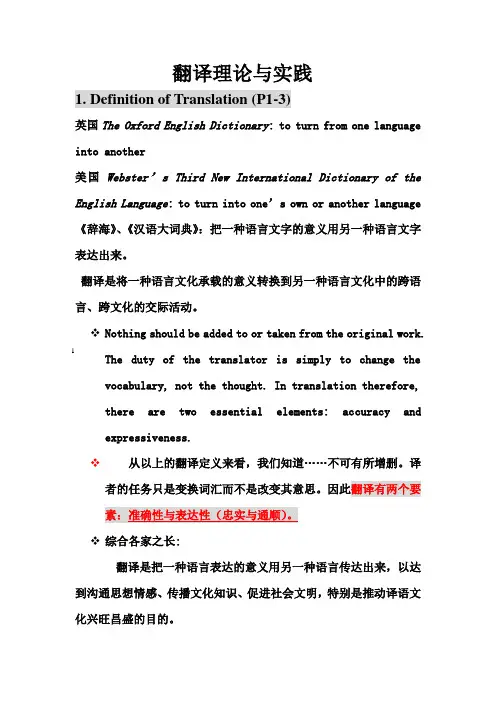
1 翻译理论与实践1. Definition of Translation (P1-3)英国The Oxford English Dictionary: to turn from one language into another美国Webster’s Third New International Dictionary of the English Language: to turn into one’s own or another language 《辞海》、《汉语大词典》:把一种语言文字的意义用另一种语言文字表达出来。
翻译是将一种语言文化承载的意义转换到另一种语言文化中的跨语言、跨文化的交际活动。
❖Nothing should be added to or taken from the original work.The duty of the translator is simply to change thevocabulary, not the thought. In translation therefore,there are two essential elements: accuracy and expressiveness.❖从以上的翻译定义来看,我们知道……不可有所增删。
译者的任务只是变换词汇而不是改变其意思。
因此翻译有两个要❖综合各家之长:翻译是把一种语言表达的意义用另一种语言传达出来,以达到沟通思想情感、传播文化知识、促进社会文明,特别是推动译语文化兴旺昌盛的目的。
2 Three key words from the definitions❖ 1. Textual (What we usually translate are texts rather thanindependent words or sentences.)Eg. 警幻道:“此茶出在放春山遣香洞,又以仙花灵叶上所带之宿露而烹,此茶名曰‘千红一窟’。

汉英翻译基础教程第一章汉英词汇比较与翻译第一节翻译中的选义一、结合语境选择较贴切的译文1. b2. a3. b4. a二、译出下列词语,注意词语的不同搭配1. a swarm of beesa brood of chickensa litter of pups2. a bevy of beautiful ladiesa pack of houndsa team of ducksa herd of antelopes3. unfailing supportproactive fiscal policymake effective use of overseas resources4. make a phone calltake a taxiknit a woolen sweaterfetch waterplay basketballspray insecticide5. basic wagecapital constructionessential commodityprimary industryfundamental interest三、翻译下列句子,注意画线词语的理解1. The two leaders exchanged views on bilateral relations and issues of common concern2. Party members should listen carefully to the opinions of the general public.3. They offered some suggestions for the revision of the plan.4. Everyone complained against such a practice.5. They had a dispute at the meeting.6. You should follow the doctor's advice.7. They reached a consensus on this issue.8. There is still some unfinished business to settle.9. We have consulted him about the matter.10. Please go back. There is nothing of your concern now第二节翻译中的选词一、翻译下列各句,注意词的选择和搭配。

《英汉翻译教程》第一章 总论 翻译是运用一种语言把另一种语言所表达的思维内容准确完整地重新表达出来的语言翻译应当把原文的本意,完全正确的介绍给中国读者,使中国读者得到的概念等于英俄日德法等国的读奈达认为更准确地反映出好的翻译的实际过程是:(1)分析:从语法和语义两方面对原文的信息进行词层不对等的情况 词层不对等采取的策略 对等译法的实例 第二章 词语翻译 相关链接 family的------------------------2009年11月30日阅读 三、修辞引申 “言之无文,行之不远。
”为使译文增色,除了真实地再现原作中包含的内容外We should simplify procedures and take prompt action to import urgently needed technology ( Georges 是他的大臣Cardinal Georges )。
本例背景是美国前国务卿黑格辞职,而由 George Schu Despite their differences , their love will conquer. 尽管他们之间存在着分歧,他们的恋爱1.运用语境 这种手段主要用于语篇上找不到明显的衔接标记,但从意义上来讲是连贯统一的。
接表达出来的语言活动。
(张培基等 1983) 我国早期典籍《周礼·秋官司寇》篇里就有“象胥于英俄日德法等国的读者从原文得来的概念。
(瞿秋白:1931) “动态对等”(Dynamic Equivalence)是奈方面对原文的信息进行分析;(2)传译:译者在脑子里把经过分析的信息从原语转译成译语;(3)重新组织:把相关链接 family的译法: 原文:Do you have a family? 译文1:你有家庭吗? 译文2:你成家了吗? 辨析:现原作中包含的内容外,还得讲究修辞。
这样,在翻译时,往往因修辞需要而增添一些引申意义。
任文英汉口译教程(一)任文英汉口译教程1. 介绍什么是任文英汉口译•任文英汉口译是一种将英语和汉语进行即场翻译的技能。
•它需要对两种语言的语法、词汇和文化有深入的理解。
为什么学习任文英汉口译•任文英汉口译是一项重要的职业技能,能够为个人带来稳定的收入。
•学习任文英汉口译可以帮助你更好地理解和跨越不同文化之间的沟通障碍。
2. 基本技能英语和汉语的语法和词汇•学习和熟悉英语和汉语的语法规则和词汇是进行口译的基础。
•需要掌握常见的词汇和短语,并且了解它们在不同语境中的意思。
听力技巧•提高听力技巧是进行口译的关键。
•练习听力理解,包括辨别不同口音、语速和语气的能力。
口语表达能力•有效的口语表达是进行口译的重要要素。
•练习口语表达,包括发音、语调和流利度的提高。
3. 提高技巧词汇积累•积累各种领域的词汇是提高口译技能的关键。
•阅读英语和汉语的文本,注意词汇的使用和上下文的语义。
文化背景了解•了解英语和汉语背后的文化背景对于进行口译至关重要。
•学习相关的历史、地理、宗教和社会习俗等方面的知识。
实践口译•参与口译活动和实践是提高口译技能的有效途径。
•可以参加会议、座谈会、翻译实习等活动,提高口译的实际运用能力。
4. 常见问题解答口语速度的问题•如何在快速的对话中保持准确的口译?•练习听取快速口语的相关素材,并进行反复练习。
语法和词汇的问题•如何在语法和词汇方面提高口译的准确性?•阅读大量的英语和汉语文本,注意语法和词汇的正确应用。
文化差异的问题•如何应对不同文化之间的语言障碍?•学习不同文化的习俗、礼仪和价值观,以更好地理解和沟通。
以上是一份简要的任文英汉口译教程,希望对你提供帮助和指导。
请按照教程中的指导逐步提高口译的技能,并不断进行实践和练习。
祝你成功!。
If it worked once, it can work twice⑽一次得手,再次不愁例2:The child has started going on all fours.孩子会爬了1.He has a weakness for smokingB.他有抽烟的癖好。
2.A cat is a cleanly animalB.猫是喜爱清洁的动物。
He is dead,as I liveB.他的确死了。
4.His English leaves nothing to be desiredB.他的英语无可挑剔。
5.I would rather have his room than his companyB.我宁愿他不在。
6.Your loss is nothing to mineA.你的损失与我无关7.The patient is waiting to cross the StyxB.这个病人已经等死了。
8.The headmaster made an example of the boy.B.校长惩罚这个孩子,目的在于警告他人。
9.The Disney management is stressing this tradition in an apparent response to suggestions that is culturally insensitive.B. 迪斯尼管理强调,这一传统显然是有人对迪斯尼管理在文化传统方面麻木不仁的态度所提出的种种建议。
10.The effort to shield assets to be passed on to children and grandchildren is making prenups more common among retired people in their 60s and 70s who are remarrying after a spouse has died.B. 努力保护自己的婚前契约,把财产能传到儿孙手中,这在已退休并丧偶、又准备再婚的六七十岁的老人当中十分普遍。